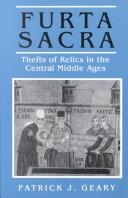| Listing 1 - 10 of 145 | << page >> |
Sort by
|
Book
Year: 1930 Publisher: London: Watts,
Abstract | Keywords | Export | Availability | Bookmark
 Loading...
Loading...Choose an application
- Reference Manager
- EndNote
- RefWorks (Direct export to RefWorks)

ISBN: 0674002458 9780674002456 9781684173389 1684173388 Year: 2000 Publisher: Boston : Leiden; Boston : Harvard University Asia Center, BRILL,
Abstract | Keywords | Export | Availability | Bookmark
 Loading...
Loading...Choose an application
- Reference Manager
- EndNote
- RefWorks (Direct export to RefWorks)
Focusing on the ninth to the fourteenth centuries, this study analyzes the ways in which relics functioned as material media for the interactions of Buddhist clerics, the imperial family, lay aristocrats, and warrior society and explores the multivocality of relics by dealing with specific historical examples. Brian Ruppert argues that relics offered means for reinforcing or subverting hierarchical relations. The author's critical literary and anthropological analyses attest to the prominence of relic veneration in government, in lay practice associated with the maintenance of the imperial line and warrior houses, and in the promotion of specific Buddhist sects in Japan.
Gautama Buddha --- Relics. --- Relics
Book
ISBN: 1684173388 Year: 2000 Publisher: Boston : Leiden; Boston : Harvard University Asia Center, BRILL,
Abstract | Keywords | Export | Availability | Bookmark
 Loading...
Loading...Choose an application
- Reference Manager
- EndNote
- RefWorks (Direct export to RefWorks)
Relics. --- Gautama Buddha --- Relics.
Book
Year: 1688 Publisher: London, : Printed by W. D[owning]. And are to be sold by Randal Taylor, near Stationers-Hall,
Abstract | Keywords | Export | Availability | Bookmark
 Loading...
Loading...Choose an application
- Reference Manager
- EndNote
- RefWorks (Direct export to RefWorks)
eebo-0018
Book
Year: 1561 Publisher: Prynted at London : By Rouland Hall, dwellyng in Goldyng lane at the sygne of the thre arrowes,
Abstract | Keywords | Export | Availability | Bookmark
 Loading...
Loading...Choose an application
- Reference Manager
- EndNote
- RefWorks (Direct export to RefWorks)
eebo-0018
Relics --- Reliquaries
Book
Year: 1688 Publisher: London : printed by W. D[owning]. and are to be sold by Randal Taylor, near Stationers-Hall,
Abstract | Keywords | Export | Availability | Bookmark
 Loading...
Loading...Choose an application
- Reference Manager
- EndNote
- RefWorks (Direct export to RefWorks)
eebo-0055
Book
Year: 1688 Publisher: London, : Printed by J.B. and are to be sold by Randal Taylor, near Stationers Hall,
Abstract | Keywords | Export | Availability | Bookmark
 Loading...
Loading...Choose an application
- Reference Manager
- EndNote
- RefWorks (Direct export to RefWorks)
eebo-0018
Book
ISBN: 9781527587311 1527587312 1527587304 9781527587304 Year: 2022 Publisher: Newcastle upon Tyne, UK
Abstract | Keywords | Export | Availability | Bookmark
 Loading...
Loading...Choose an application
- Reference Manager
- EndNote
- RefWorks (Direct export to RefWorks)
This volume presents the latest historical, theological and site-specific developments in the study of the Image of Edessa, shedding new light onto various different aspects of the icon. Experts from Russia, Spain, Australia, Georgia, Italy and the United Kingdom bring their latest findings together in order to reach a deeper understanding of this fascinating object.

ISBN: 9786613135704 1400820200 1283135701 9781400820207 0691052611 9780691052618 0691008620 9780691008622 Year: 2011 Publisher: Princeton, NJ
Abstract | Keywords | Export | Availability | Bookmark
 Loading...
Loading...Choose an application
- Reference Manager
- EndNote
- RefWorks (Direct export to RefWorks)
To obtain sacred relics, medieval monks plundered tombs, avaricious merchants raided churches, and relic-mongers scoured the Roman catacombs. In a revised edition of Furta Sacra, Patrick Geary considers the social and cultural context for these acts, asking how the relics were perceived and why the thefts met with the approval of medieval Christians.
Social history --- Theft of relics --- Relics
Book
Year: 1966 Publisher: Stockholm : Nationalmuseum,
Abstract | Keywords | Export | Availability | Bookmark
 Loading...
Loading...Choose an application
- Reference Manager
- EndNote
- RefWorks (Direct export to RefWorks)
| Listing 1 - 10 of 145 | << page >> |
Sort by
|

 Search
Search Feedback
Feedback About UniCat
About UniCat  Help
Help News
News